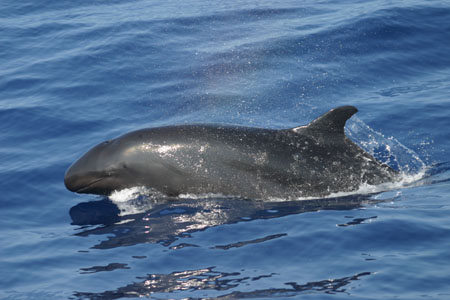FKW Injury: Another false killer whale has been injured in an interaction with the Hawai‘i longline fishery. This time, the interaction occurred when a shallow-set longliner targeting swordfish hooked the animal, making it an extremely unusual event. Interactions between false killer whales and longliners usually occur in the deep-set longline fishery, which targets tuna.

The interaction, which occurred on May 25, occurred inside Exclusive Economic Zone around Hawai‘i. The on-board observer’s report stated that the animal was as close as 3 to 4 feet from the vessel when “the whale pulled the entire line out of the crew’s hands before they could attempt to release it.” It swam away, trailing about 40 feet of monofilament line.
A preliminary review determined that the interaction was a serious injury.
Hawai‘i’s population of false killer whales is endangered. While take limits are in place for the deep-set longliners, none exists for the shallow-set. Robin Baird of the Cascadia Research Collective – perhaps the foremost expert on false killer whales – said that this interaction “will just count as one individual towards PBR,” or potential biological removal, the number of individuals that can be removed – i.e., killed – without harming the population’s chances of recovery.
“My biggest concerns (as they’ve been for a while) are biased estimates of bycatch, given that there are no observer programs in non-longline fisheries,” Baird told Environment Hawai‘i in an email exchange. Those fisheries include shortline and other hook-and-line fisheries. Also, he went on to say, there is likely “some unknown level of under-reporting by observers (either because they are sick in their bunks and not recording, or for other reasons), and the potential for an observer effect for how animals are handled when observers are onboard.” (Observers are required on all shallow-set longliners, but on just 20 percent of the deep-set vessels.)
Finally, in addition to all that, there’s “the uncounted non-U.S. bycatch outside the U.S. EEZ,” he said.
“Whether combined these would push bycatch estimates above PBR is simply unknown.”
SEZ Reopens: On August 26, Hawai‘i-based tuna longliners were allowed to enter once more the Southern Exclusion Zone, a large swath of the U.S. EEZ that had been closed since February 2019 as a result of the deep-set longline fleet having exceeded the allowable take of false killer whales.

The National Marine Fisheries Service notified the False Killer Whale Take Reduction Team of the reopening in a letter August 17. In it, Ann Garrett, assistant administrator (Protected Resources Division) of NMFS’ Pacific Islands Regional Office, said that the service determined that the action could be taken since a condition of reopening had been met. That condition, set out in the False Killer Whale Take Reduction Plan, is met if “the average estimated level of false killer whale incidental M&SI [mortality and serious injury] in the deep-set longline fishery within the remaining open areas of the EEZ around Hawai‘i for up to the five most recent years is below the PBR level for the Hawai‘i Pelagic stock of false killer whales at that time.”
Based on recent studies, Garrett continued, the PBR for the pelagic false killer whales in the EEZ was calculated to be 16, while the five-year average estimated M&SI take attributed to the deep-set longliners was calculated to be 9.8.
Relief Granted: Kaua‘i vacation rental owners Elizabeth Kendrick and Joe Chaulkin have convinced the Fifth Circuit Court that the county erred in December 2017 when it rejected their belated application to renew their non-conforming use permit.
Among other things, their attorneys argued that the owners were not given proper notice of the rule change. They pointed out that while the county Planning Commission’s 2017 Interpretive Rules require late applications to automatically be denied, a final version of these rules were not posted to the county’s website until early 2018. Under the previous version of the rules, applicants were allowed a 30-day grace period to renew their permits, so long as they paid twice the application fee.
At a hearing in July, the court found in their favor. On August 21, their attorneys submitted their proposed final order for the court’s approval.

Leave a Reply